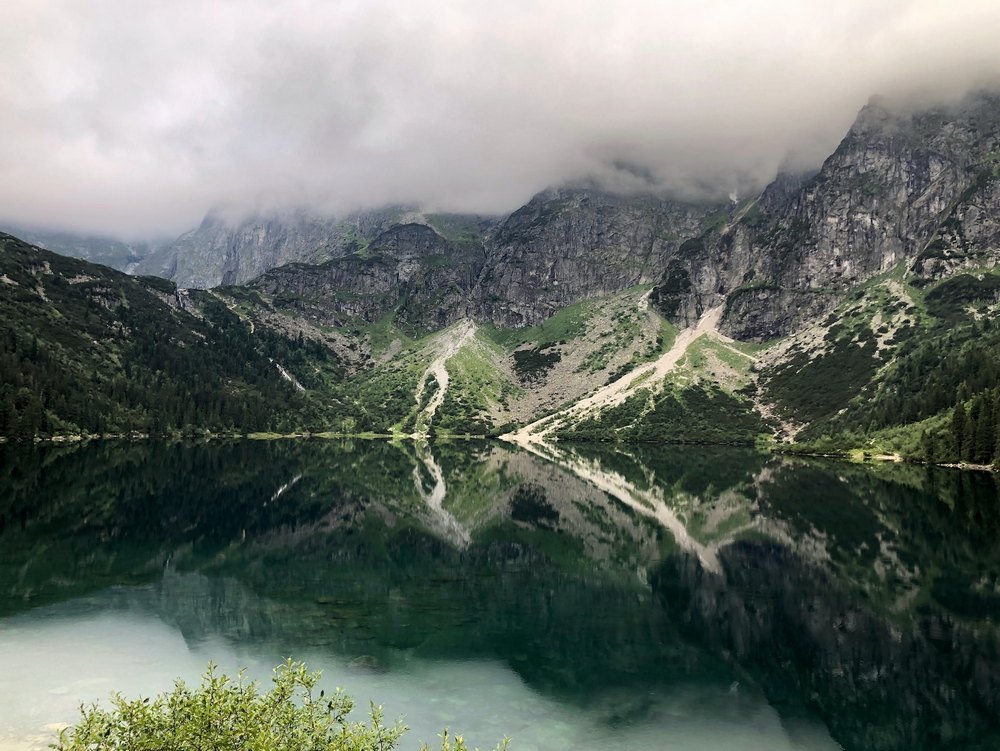Nestled in the heart of Europe, Poland boasts a diverse landscape that offers stunning natural attractions, many of which are found in its vast mountain ranges. Whether you’re an experienced hiker looking for a challenging trek or a casual traveler seeking breathtaking views, Poland’s mountains have something for everyone. In this article, we will take you on a journey through the most scenic trails and picturesque peaks, unveiling the unique charm and beauty of each region. So grab your hiking boots and get ready to explore the captivating world of the Polish mountains.
Unveiling the Beauty of the Tatra Mountains
The Tatra Mountains, a majestic range located on the border of Poland and Slovakia, offer a breathtaking experience for hikers and nature enthusiasts alike. Known as the highest mountain range in the Carpathian Mountains, the Tatras are characterized by their dramatic peaks, pristine alpine lakes, and verdant valleys.
The region’s unique flora and fauna, coupled with its diverse geological features, make it a captivating destination for adventurers seeking a memorable experience. Hiking trails in the Tatra Mountains cater to all levels of fitness and experience, with well-marked routes that range from leisurely strolls to challenging climbs.
The Tatra National Park, which encompasses a significant portion of the Polish Tatras, is a UNESCO Biosphere Reserve that preserves and protects the area’s diverse ecosystems. It is home to iconic landmarks such as the Rysy, the highest peak in Poland, and the picturesque Morskie Oko, a must-see glacial lake surrounded by towering peaks.
Whether you’re exploring the scenic valleys of the Western Tatras or conquering the challenging trails of the High Tatras, the Tatra Mountains promise a truly unforgettable experience for all who venture into their enchanting landscapes.
The Enchanting Bieszczady Mountains: A Paradise for Hikers
The Bieszczady Mountains, situated in the southeastern part of Poland, are a part of the Eastern Carpathians and extend into Ukraine and Slovakia. This remote and lesser-known region is a true paradise for hikers, with its rolling hills, untouched wilderness, and serene landscapes.
One of the most alluring aspects of the Bieszczady Mountains is their untamed beauty, which allows visitors to experience nature in its purest form. The Bieszczady National Park, established to protect the area’s unique ecosystems, is home to a rich variety of flora and fauna, including the European bison, brown bear, and the Eurasian lynx.
The hiking trails in the Bieszczady Mountains are a perfect blend of captivating scenery and moderate difficulty, making them accessible to both seasoned hikers and those new to the activity. Some of the most popular trails include the path to Tarnica, the highest peak in the region, and the Połoniny Ridge, which offers stunning panoramic views of the surrounding landscapes.
Aside from its natural beauty, the Bieszczady Mountains are also steeped in history and culture, with numerous ancient wooden churches, abandoned villages, and remnants of the past scattered throughout the region. Hiking in the Bieszczady Mountains is not just a physical adventure, but also a journey through time, as you uncover the hidden stories behind this enchanting corner of Poland.
Discovering the Karkonosze Mountains: Home to Poland’s Highest Waterfall
The Karkonosze Mountains, straddling the border between Poland and the Czech Republic, are a captivating destination for hikers and nature enthusiasts. Part of the Sudetes mountain range, the Karkonosze Mountains boast an impressive variety of landscapes, from rugged peaks to lush forests and picturesque valleys.
A significant highlight of this region is the Karkonosze National Park, which protects the area’s unique ecosystems, including the highest waterfall in Poland, the 27-meter (89 feet) tall Kamienczyk Waterfall. This breathtaking cascade is nestled within a deep gorge, surrounded by lush vegetation, and can be reached via a well-maintained hiking trail.
The Karkonosze Mountains offer a diverse range of hiking trails suitable for all skill levels, from leisurely walks through scenic valleys to more challenging treks up steep slopes. The highest peak in the range, Śnieżka, stands at 1,603 meters (5,259 feet) and provides a rewarding challenge for experienced hikers, offering panoramic views of the surrounding landscape from its summit.
The region is also rich in cultural heritage, with numerous historic sites such as the medieval Wang Church, which was transported from Norway and reassembled in the town of Karpacz, and the picturesque Książ Castle, nestled in the nearby Walbrzych Mountains.
Exploring the Karkonosze Mountains reveals not only the awe-inspiring beauty of Poland’s highest waterfall but also the opportunity to immerse yourself in the region’s rich history and diverse natural landscapes.
Experience the Tranquil Charm of the Pieniny Mountains
The Pieniny Mountains, a relatively small but enchanting range situated on the border of Poland and Slovakia, are known for their picturesque landscapes, tranquil charm, and diverse range of outdoor activities. This captivating region, with its limestone cliffs, rolling hills, and winding rivers, offers a serene escape from the hustle and bustle of daily life.
One of the most iconic landmarks in the Pieniny Mountains is the Dunajec River Gorge, a dramatic stretch of the river that meanders through towering limestone cliffs. The gorge can be explored on foot or by taking a traditional wooden raft trip, providing a unique and leisurely way to experience the stunning scenery.
The Pieniny National Park, which encompasses the Polish portion of the range, is home to a wide variety of flora and fauna, including the rare endemic Pieniny dandelion and the endangered European pond turtle. Hiking trails in the area cater to all levels of experience, with the most famous being the route to the summit of Trzy Korony (Three Crowns), which offers panoramic views of the surrounding valleys and the distant Tatra Mountains.
In addition to its natural beauty, the Pieniny Mountains are also steeped in cultural heritage, with numerous historical sites such as the 14th-century Czorsztyn Castle and the picturesque village of Szczawnica, known for its mineral springs and charming architecture.
A visit to the Pieniny Mountains allows you to experience the tranquil charm of this captivating region, immersing yourself in its breathtaking landscapes and rich cultural history while creating unforgettable memories.
The Beskid Mountains: A Journey Through Lesser-Known Trails
The Beskid Mountains, a vast range that stretches across southern Poland and into Slovakia, the Czech Republic, and Ukraine, offer a unique opportunity for hikers and nature lovers seeking to explore lesser-known trails and immerse themselves in a more authentic experience. This expansive region is characterized by its rolling hills, dense forests, and quaint villages, providing a serene backdrop for memorable outdoor adventures.
Unlike the more popular Tatra and Karkonosze ranges, the Beskid Mountains remain relatively unspoiled by mass tourism, allowing visitors to enjoy a more peaceful and intimate connection with nature. The Beskids are divided into several subranges, including the Beskid Sądecki, Beskid Żywiecki, and Beskid Makowski, each with its distinct landscapes and attractions.
Hiking trails in the Beskid Mountains cater to a wide range of skill levels, from gentle walks through picturesque valleys to more challenging treks up to remote peaks. One of the most popular destinations in the area is Babia Góra, the highest peak of the Beskid Żywiecki range, which offers breathtaking panoramic views from its summit.
In addition to their natural beauty, the Beskid Mountains are also rich in cultural heritage, with numerous historical sites such as wooden churches, traditional mountain huts, and vibrant folk festivals that showcase the region’s customs and traditions.
Embarking on a journey through the lesser-known trails of the Beskid Mountains provides a truly unique and authentic experience, allowing you to connect with the unspoiled beauty of Poland’s diverse landscapes and delve into the rich cultural history of this captivating region.
The Gorce Mountains: Where Nature Meets History
The Gorce Mountains, a small but captivating range in southern Poland, offer a perfect blend of natural beauty and historical intrigue, making them an ideal destination for hikers and history enthusiasts alike. Located within the larger Carpathian mountain range, the Gorces are characterized by their lush forests, gentle slopes, and picturesque meadows, which provide a tranquil setting for outdoor adventures.
The Gorce National Park, established to protect the area’s unique ecosystems, is home to a rich variety of flora and fauna, including the European bison, deer, and numerous bird species. Hiking trails in the Gorce Mountains cater to all levels of experience, with well-marked routes that traverse scenic valleys, dense forests, and beautiful alpine meadows.
One of the highlights of the Gorce Mountains is the historic Turbacz mountain hut, situated near the highest peak in the range, Turbacz. This charming hut, which dates back to the early 20th century, provides a cozy retreat for hikers and offers a glimpse into the region’s past. The surrounding area is also dotted with numerous wooden chapels and churches, showcasing the traditional architecture of the region.
In addition to their natural beauty, the Gorce Mountains are steeped in history, with many trails leading to fascinating remnants of World War II and the Polish resistance movement. One such example is the secret underground bunker in the village of Nowy Targ, which served as a hideout for Polish partisans during the war.
Exploring the Gorce Mountains is a journey through both nature and history, offering visitors the opportunity to immerse themselves in the area’s captivating landscapes and uncover the stories behind its rich cultural heritage.
Łysa Góra: A Religious Pilgrimage to the Holy Cross Mountains
Łysa Góra, also known as the Bald Mountain, is a significant peak in the Holy Cross Mountains (Świętokrzyskie Mountains) located in central Poland. Steeped in history and religious significance, Łysa Góra has been a sacred site and a popular destination for religious pilgrimages for centuries.
Atop the mountain, the Holy Cross Monastery, which dates back to the 11th century, is a major attraction for both pilgrims and tourists. The monastery houses a revered relic, a fragment of the Holy Cross, which is believed to have been brought to Poland by Saint Otto of Bamberg in the 12th century. This sacred relic has made Łysa Góra one of the most important Christian pilgrimage sites in Poland.
The journey to the summit of Łysa Góra is both a physical and spiritual experience, as the hiking trails are lined with numerous chapels, shrines, and stations of the cross, offering a serene and contemplative atmosphere. The trails cater to all levels of fitness and experience, with well-maintained paths leading through lush forests and offering panoramic views of the surrounding landscape.
Aside from its religious significance, the Holy Cross Mountains are also home to a rich variety of flora and fauna, as well as unique geological formations such as the mysterious Łysa Góra’s bald peak, which is covered in a distinctive thin layer of soil, giving the mountain its name.
Embarking on a religious pilgrimage to Łysa Góra in the Holy Cross Mountains offers a truly unique and enriching experience, allowing visitors to connect with Poland’s rich religious heritage while immersing themselves in the area’s captivating natural beauty.
The Stołowe Mountains: Exploring the Land of Table-Shaped Plateaus
The Stołowe Mountains, also known as the Table Mountains, are a fascinating range situated in southwestern Poland, near the Czech border. This unique and otherworldly landscape is characterized by its flat, table-shaped plateaus and labyrinthine sandstone rock formations, which have been shaped by millennia of erosion.
The Stołowe Mountains National Park, established to protect and preserve this extraordinary landscape, offers a wealth of hiking trails and scenic viewpoints that showcase the area’s distinctive geological features. Some of the most popular attractions in the park include the Szczeliniec Wielki, the highest peak in the range, which offers panoramic views from its plateau, and the Błędne Skały, a maze-like network of sandstone formations that can be explored via a series of wooden walkways.
Hiking in the Stołowe Mountains is an adventure like no other, as the trails lead through dense forests, narrow gorges, and along the edges of dramatic cliffs, providing a thrilling experience for visitors of all ages and skill levels. The region is also home to a diverse array of flora and fauna, including several endemic species that are unique to this unusual environment.
In addition to its natural wonders, the Stołowe Mountains also boast a rich cultural history, with nearby towns such as Kudowa-Zdrój and Duszniki-Zdrój offering charming architecture, historic sites, and traditional Polish hospitality.
Exploring the land of table-shaped plateaus in the Stołowe Mountains provides a truly unique and unforgettable experience, allowing visitors to immerse themselves in the captivating beauty and geological intrigue of this extraordinary corner of Poland.
The Świętokrzyskie Mountains: Delving into Ancient Geological Formations
The Świętokrzyskie Mountains, also known as the Holy Cross Mountains, are a captivating range located in central Poland, offering a treasure trove of ancient geological formations and a rich cultural history. These mountains, characterized by their gentle slopes, dense forests, and picturesque valleys, provide a serene backdrop for outdoor enthusiasts and history buffs alike.
The geological history of the Świętokrzyskie Mountains dates back over 500 million years, making them some of the oldest mountains in Europe. The region’s unique geological features include the Kielce-Łagów Syncline, which contains valuable Paleozoic fossils, and the Jaskinia Raj (Paradise Cave), a mesmerizing karst cave system adorned with stunning stalactite and stalagmite formations.
The Świętokrzyskie Mountains are home to numerous well-maintained hiking trails that cater to a wide range of skill levels, from leisurely walks through idyllic valleys to more challenging treks up to remote peaks. These trails offer an opportunity to delve into the area’s ancient geological formations, including quartzite outcrops, sandstone cliffs, and limestone caves, as well as to explore the region’s diverse flora and fauna.
In addition to their natural beauty, the Świętokrzyskie Mountains are steeped in cultural heritage, with numerous historical sites such as the already mentioned Holy Cross Monastery atop Łysa Góra, the 9th-century Krzemionki Opatowskie, a prehistoric flint mine, and the medieval castles of Chęciny and Sandomierz.
Embarking on a journey through the Świętokrzyskie Mountains offers a unique opportunity to immerse yourself in the region’s ancient geological formations while uncovering the rich cultural history of this captivating part of Poland.
Essential Hiking Tips for a Memorable Adventure in Poland’s Mountains
Poland’s diverse and picturesque mountain ranges offer an array of hiking opportunities for outdoor enthusiasts. From the towering peaks of the Tatra Mountains to the serene beauty of the Pieniny Mountains, each region provides its unique charm and challenges. To ensure a memorable and safe adventure in Poland’s mountains, consider the following essential hiking tips:
- Plan your route: Research the area you plan to visit and choose a trail suitable for your fitness level and experience. Make sure to check trail conditions, the difficulty level, and estimated duration. Online resources, guidebooks, and local tourist information centers can provide valuable information.
- Check the weather forecast: Mountain weather can be unpredictable, and conditions can change rapidly. Always check the weather forecast before setting out and be prepared to adjust your plans accordingly.
- Pack appropriate clothing and gear: Dress in layers to adapt to changing temperatures, and ensure you have waterproof clothing and sturdy hiking boots. A backpack with essential items such as a map, compass, water, snacks, a first aid kit, and a fully charged mobile phone is also crucial.
- Leave a trip plan: Inform someone of your planned route, expected return time, and any changes you make to your itinerary. This information can be invaluable in case of an emergency.
- Respect the environment: Follow the principles of Leave No Trace, which include disposing of waste properly, minimizing campfire impact, and respecting wildlife and plants. Stay on designated trails to avoid damaging fragile ecosystems.
- Know your limits: Listen to your body and be realistic about your abilities. Do not hesitate to turn back if you feel unwell, the weather deteriorates, or the trail becomes too challenging.
- Stay on marked trails: To ensure your safety and protect the environment, always follow marked trails and obey any signs or notices posted by park authorities.
- Be prepared for emergencies: Familiarize yourself with basic first aid procedures and carry a whistle to signal for help. In case of an emergency, call the Mountain Volunteer Search and Rescue in Poland (GOPR) at 985 or the general emergency number 112.
- Respect local customs and traditions: When visiting villages and towns in the mountainous regions, be considerate of local customs, traditions, and beliefs.
- Enjoy the experience: Take your time, soak in the breathtaking landscapes, and make unforgettable memories while exploring Poland’s stunning mountain ranges.
By following these essential hiking tips, you can embark on a memorable adventure in Poland’s mountains while ensuring your safety and preserving the natural beauty of these remarkable landscapes for future generations to enjoy.










